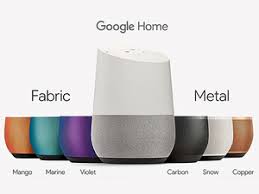Voice-First. The rapid growth of the market for voice-enabled technologies, sparked by the popularity of the Amazon Echo, has the potential to be as disruptive a technology change as any that preceded it. Some are describing this new trend for devices and software is known as Voice-First, that is, the primary interface to the technology is spoken. These offerings are found within hardware, some of which is designed to include Smart Home features. Examples include the ‘smart speaker’ Amazon Echo product line, Google Home, and in 2018, Apple HomePod. And Voice-First is built into software such as new smart, personal, digital, and virtual assistants. Note examples that are part of platform ecosystems: Alexa, Siri, Cortana, Samsung’s Bixby, and Google Assistant. The category also includes voice interaction with devices as disparate as wearables, tablets, security alarms, healthcare interactions, and cars. Since this is an early, even Version 1.1 market, many more Voice-First examples are forthcoming, maybe even next week!
Voice-First for Boomer-Senior Markets. In the boomer-senior segments, hardware has emerged with Voice-First interfaces, including LifePod and Nucleus Life. In addition, software add-ons multiply, including the Amazon Skills library of 26,000 (as of November, 2017), including Orbita Engage for Care Coordination. AskMarvee has introduced a training program called Aging with Alexa to help caregivers and older adults familiarize themselves with the technology. Voice-First technology, with its natural language interface and AI underpinnings, can understand spoken requests and commands in multiple languages --Apple’s Siri supports multiple languages and countries.
How can Voice First Help Older Adults – now and in the future? Voice-First technology is used to answer questions, play music, read books aloud, interact with network-connecte d devices and offer scheduled alerts. As of November, 2017, Amazon has sold more than 20 million of these devices. Product features are regularly added via the cloud, eliminating the requirement for user-dependent software upgrades – and perhaps even the initial startup that requires a smartphone. For example, customization for specific voices, nesting queries within a context, or setting topic-specific timers or alarms. But are each of these features simply that – features? Is there a larger offering, perhaps for use in managing personal environments, that will be useful for individuals with hearing, vision or mobility limitations? Perhaps changing the communication paradigm in senior living environments? Or with family members – what does it mean to 'Drop In' on an older adult via one of these Voice-First devices?
d devices and offer scheduled alerts. As of November, 2017, Amazon has sold more than 20 million of these devices. Product features are regularly added via the cloud, eliminating the requirement for user-dependent software upgrades – and perhaps even the initial startup that requires a smartphone. For example, customization for specific voices, nesting queries within a context, or setting topic-specific timers or alarms. But are each of these features simply that – features? Is there a larger offering, perhaps for use in managing personal environments, that will be useful for individuals with hearing, vision or mobility limitations? Perhaps changing the communication paradigm in senior living environments? Or with family members – what does it mean to 'Drop In' on an older adult via one of these Voice-First devices?
This week marks the launch of this research effort. Beyond previous aggregation of offerings, this topic needs exploring over the coming months – and interviews with experts are being scheduled. Is Voice-First engagement really an improvement – or is it a distraction for older adults? Can providers who offer additional skills and services through Voice-First interfaces make money? Is there a smooth sequencing of interactions begun as Voice-First and continuing in another domain, for example, interactions about health-related appointments and schedules? What are the limitations of Voice-First? What is the potential for misunderstanding and miscommunication about or with older adults? And what other aspects of the topic would you want to see covered in this research? Your thoughts welcome.
from Tips For Aging In Place https://www.ageinplacetech.com/blog/considering-future-voice-first-and-older-adults
No comments:
Post a Comment
Note: Only a member of this blog may post a comment.